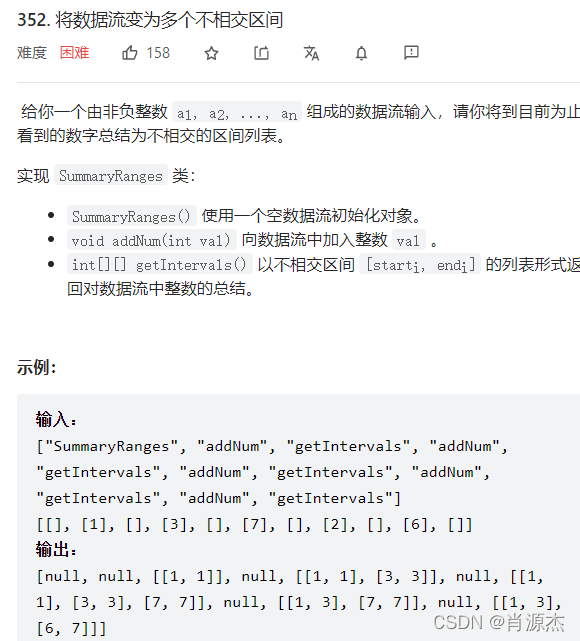

可以用multimap或者 multiset去维护有序空间,这里用multiset,里面设置为pair<int,int>, 用来存放内部区间的左右两个端点。加入两个哨兵节点
每次插入的时候使用upper_bound找到第一个大于插入的数的迭代器位置:
auto l = S.upper_bound({x, -1e8});
注意这里S是mutiset的 一个对象,里面排序的规则是先用first排序后在用second排序,也就是说当first相等时,second小的排在前面,这里第二个second用一个最小的数值,正好找到第一个大于等于他的迭代器,–l就是第一个小于等于他的迭代器。
分三种情况讨论, 见代码
注意define 在 class以外, 关于迭代器的first和second,这两种等同:(*l).first <=====> l->first
code
#define a first
#define b second
class SummaryRanges {
public:
typedef pair<int,int> PII;
multiset<PII>S;
SummaryRanges() {
S.insert({-1e8, -1e8});
S.insert({1e8, 1e8});
}
void addNum(int x) {
auto l = S.upper_bound({x, -1e8});
auto r = l;
--l;
if ((*l).b + 1 == x && x == (*r).a - 1) {
S.insert({(*l).a, (*r).b});
S.erase(l);
S.erase(r); //此时还是指向l和r的迭代器
}
else if ((*l).b + 1 == x) {
S.insert({(*l).a, x});
S.erase(l);
}
else if (x == (*r).a - 1) {
S.insert({x, (*r).b});
S.erase(r);
}
else if ((*l).b + 1 < x && (*r).a - 1 > x) S.insert({x, x});
}
vector<vector<int>> getIntervals() {
vector<vector<int>> res;
for (auto s : S) {
if (s.a == -1e8 || s.a == 1e8) continue;
res.push_back({s.a, s.b});
}
return res;
}
};
/**
* Your SummaryRanges object will be instantiated and called as such:
* SummaryRanges* obj = new SummaryRanges();
* obj->addNum(val);
* vector<vector<int>> param_2 = obj->getIntervals();
*/





















 3444
3444











 被折叠的 条评论
为什么被折叠?
被折叠的 条评论
为什么被折叠?








